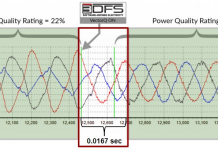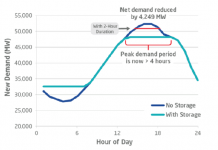Electric utilities have a process by which they project future expected demand for electricity, and then find resources, either new electric generation or energy efficiency (Demand Side Management, or DSM) resources to meet that expected demand, or reduce that demand. Progressive utilities and utility regulators now include DSM among the mix of resources as a matter of course. According to Martin Kushler, of the American Council for an Energy Efficient Economy (ACEEE) who spoke at the Southwest Regional Energy Efficiency Workshop about an upcoming report from ACEEE, DSM resources cost an average of 3 cents per kWh of energy saved, much lower than the typical 10 cents per kWh for new supply side resources. Since saving energy is not only considerably cheaper but also cleaner than new generation, including renewables, DSM resources deserve pride of place in resource planning.
Bringing DSM into resource planning has required that utility regulators change utility incentives to assure that utilities will not be undermining their own profits. In many states, this has been a slow revolution moving from traditional "least cost" planning, which focused on achieving the lowest possible cost per unit of electricity delivered, to a focus on reducing overall energy bills (either by reducing kWh used, or minimizing the price per kWh.) This goes against traditional utility instincts, which like most businesses would like to expand by increasing sales, but can be achieved by paying for reliable service, or giving incentives for efficiency.
However, there has always been one aspect of DSM which utilities have little problem with, which are various measures to reduce peak loads, either through Demand Response (payments to customers in return for turning off equipment during peak times) and peak shaving (efficiency measures which reduce peak load by shifting loads to other times of the day.) Reducing peak load is in the utility’s interest because it improves system reliability without significantly reducing total sales or expensive expenditures on peaking plants which are only used for a tiny fraction of the year.
Utility-Think
The traditional thinking breaks down demand into a base load piece, which is basically the least amount used at any time during the year, and any demand above that level. Traditionally, utilities sought to meet this demand with a mixture of base load (which runs nearly all the time) and dispatchable generation (which can be controlled, and is brought on as necessary). This thinking has run into problems as intermittent generation, such as wind and solar.
Typically, utilities express these problems as problems with intermittent technologies, calling them "unreliable," which they are if you define "reliable" as only those resources which are on 90% of the time, or which can be called on at will. That is not the definition of reliability most of us use: most people would call something reliable if it’s there when you expect it to be. With the colloquial definition, the rising and setting of the sun is about as reliable as anything gets, and the reliability of solar and wind power also follow predictable daily and seasonal cycles, limited only by our ability to predict cloudiness and windiness.
Admittedly, weather prediction is not the most reliable of sciences, especially when attempting to predict weather in small areas or gusts of wind or shadows from clouds in small areas. However, geographic diversification can smooth the fluctuations in generation from gusts of wind or shadows of clouds in an electric system with multiple solar or wind facilities spread over a broader area. The remaining unpredictability of generation for such a diversified system should be manageable by a system which has no trouble coping with customers’ unpredictable and wildly fluctuating demands for electricity.
A typical "reliable" combined-cycle gas turbine [pdf], takes 3 hours to start from cold, and can ramp up or down only 7% in power output per minute. On this time scale weathermen tend to be fairly accurate over broad regions and a few hours ahead; weathermen earn their reputation for unreliability due to the surprises which arise in forecasts for a day or two ahead, and even here improvements are on the way. For minutes ahead, the wind speed around the field should give operators a good idea of the strength of wind approaching it.
Implications for DSM
The same narrow focus on dispatchable and base load generation also leads to a focus on only two types of demand management in electric utility DSM programs. These programs are almost universally evaluated on (and hence focus on achieving) three things:
- Overall energy reduction (kWh savings)
- Peak load reduction (usage at peak times)
- Demand response (load reduction which can be called upon in times of need.)
As I argued in my article on Wind Power and Heat Pumps, there are other valuable aspects of managing demand than just these three factors. While electricity is most expensive to generate at times of peak use, the costs vary greatly throughout the rest of the year as well. In addition to the load on the system, the cost of natural gas is considerably higher in the winter than the summer, meaning that saving the same kWh of energy at the same level of load is worth more in the winter than in the summer, so long as the kWh would have been generated using the same amount of natural gas at the two times.
To be fair, the cost/benefit tests used to evaluate the effectiveness of DSM measures often do take into account such cost factors as the fuel cost I point to above, but in my experience, it is a very imprecise process, with very little attention given to timing of the savings ("load shape") beyond an attempt to quantify the coincidence with peak. At a discussion with Xcel Energy (NYSE:XEL) where they were soliciting feedback from stakeholders for the goals of a DSM Potential Study, they did not intend to ask the contractor for load shape information of various measures evaluated until I raised the issue.
Demand Planning
Over the longer term, as more electricity is generated by intermittent sources, load shape information will become increasingly important. Rather than a focus on reducing peak load, the focus will need to shift to reducing load when it exceeds available intermittent resources, and increasing useful use of electricity when renewable energy is most abundant. At even relatively small penetrations, solar generation can exceed demand on sunny mornings when the temperature is moderate, while wind can exceed demand on windy nights, especially in the winter. Even before we add enough renewables to the system that they begin to exceed demand at these times, we need to be thinking about shifting future demand to those times of relative plenty, and from those times of relative scarcity.
Such shift can easily be accomplished with electricity storage, but such storage can be quite expensive. A more economic option would be encouraging customer choices today which influence the patterns of future load. 
; Even if we can’t predict how windy it will be a week from now, we know, climate change notwithstanding, the daily and annual patterns of sun and wind five, ten, and twenty years from now. We also can reasonably expect that both wind and solar electric generation will be much higher than it is today. That extra generation will be added as part of the utilities normal process of Resource Planning, in which DSM is now finding its place. The next logical step is Demand Planning, using utility DSM programs and other tools to better meet the available future electric resource with future electric demand, supplying useful electric services to make our lives better.
Tom Konrad









“Such shift can easily be accomplished with electricity storage, but such storage can be quite expensive. A more economic option would be encouraging customer choices today which influence the patterns of future load.”
By encouraging customer choices, I can only assume that you mean offering different prices based on the time of peak demand, but doing so would ultimately make the case for distributed energy storage along the lines of what Gridpoint and similar companies seem to be doing. Because if a consumer can buy energy at off-peak prices and store it locally, they (or the utility) will recoup the investment in the storage much faster. Don’t you think?
Time of day pricing cis part of this. Just having time of day pricing is not necessarily enough to gaurantee that storage will be economic, and it is only one of many measures that a consumer can use to ship his or her load. Simply choosing to run the diswasher or dryer off peak is another. To bring this back to demand planning, the utility could encourage the save of appliances with a timed delay feature, which would make it easier for customers to shift their load off peak.